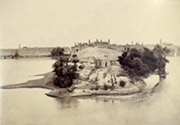Drying Saraswati caused exodus from Harappa to Gangetic belt
01 Apr 2013
Prof Mark Macklin, Prof. Geoff Duller and PhD student Julie Durcan, all of Institute for Global Environmental Strategies (IGES), worked along with a group of international geologists, geomorphologists, archaeologists and mathematicians to answer a question that has puzzled scholars for centuries: what became of the Indus or Harappan civilisation?
 |
| Photograph taken in 1860 of the ancient city of Sukkur which lies in the heart of the Indus Valley, the location of the ancient Harappa civilisation. (Out of copyright) |
The Harappan civilization stretched from what is known today as Pakistan to eastern Afghanistan, covering more than 625,000 square miles, rivaling the ancient civilisations of Egypt and Mesopotamia. It could boast indoor plumbing, gridded streets and a rich intellectual life.
This once great civilization rose about 4,500 years ago, flourished for 600 years and then declined. Previous scholars hypothesized that strife or invasion led to its demise, while others suggested environmental factors may have been to blame. The researchers who took part in this latest study, published in the Proceedings of the National Academy of Sciences, opted for climate change.
Prof Macklin said, ''By using satellite photos and topographical data, we prepared digital maps of the Indus River landscape, and collected field samples to determine the age of sediments in the region and whether their structure was shaped by rivers or the wind. The information was then overlaid across prior archaeological findings, providing a chronology of 10,000 years of human history and landscape changes.''
The Harappans relied on a dependable cycle of monsoons to feed the rivers' systems and did not create an irrigation system to support crops. However, as time passed, the monsoons gradually became more infrequent and the rivers dried up causing crop failure. There was no longer any surplus to support traders, artists and scholars and people began to abandon the cities, moving toward the Ganges basin, where rains were more dependable. The urban centres fractured into small villages and towns.
The researchers found the geologic remnants of the Hindu's legendary sacred Sarasvati river in the desert surrounding the modern-day Ghaggar-Hakra valley. It was not fed by Himalayan runoff, as had been assumed, but by the annual monsoon, and as the climate changed, the weak rains could no longer sustain the river, and it vanished.







.webp)














